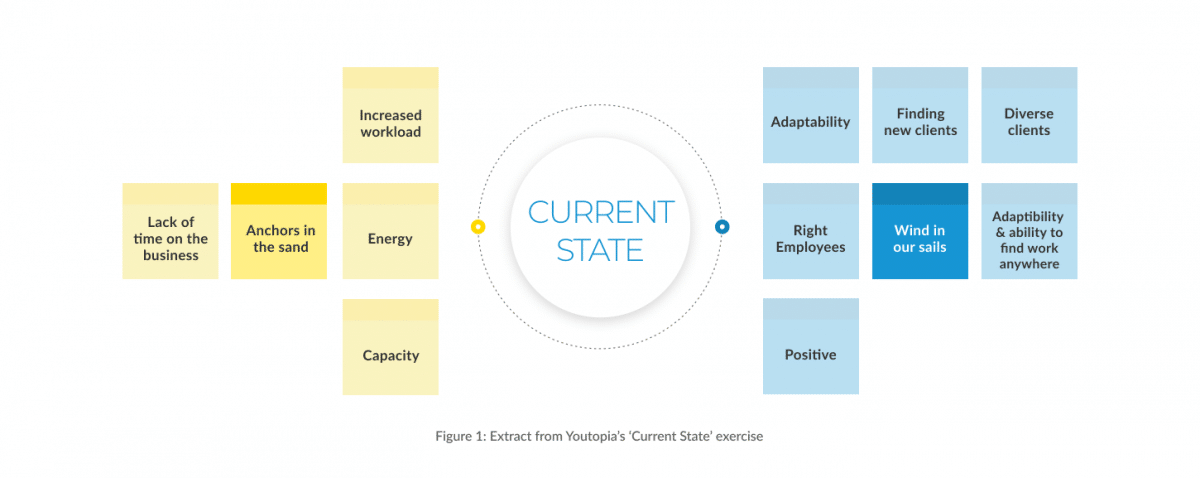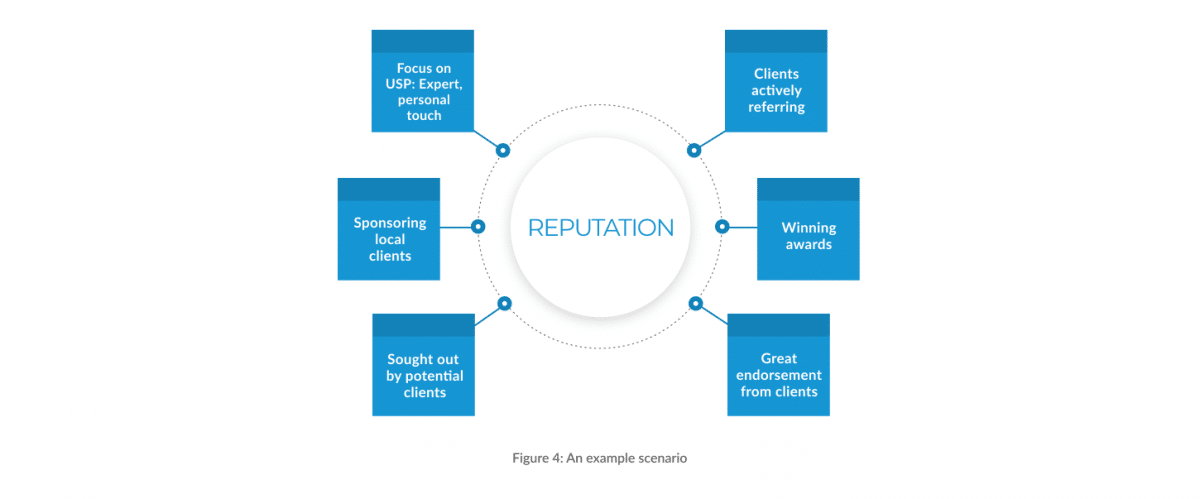Our Thinking Mon 23rd August, 2021
Using ‘Future Backwards’ to Help an Early-Stage Company Plan their Strategy Beyond the Pandemic
Youtopia Solutions is a rapidly growing Accounting firm in Milton Keynes, UK, established in 2017. Throughout the company’s life, Youtopia has faced strong headwinds around profit margins, cash flow, and balancing the acquisition of new clients with staff capacity. The resilience built as a result has helped them successfully navigate the choppy waters of the pandemic.
The two founders, David Adderson and Katherine Robertson, engaged Equal Experts to help them create a strategic plan beyond Covid. Considering Youtopia’s unique challenges and opportunities, the resulting Strategy Day was organised around the ‘Future Backwards’ technique. This article shares both the results, and some tips on how to get the most out of your own ‘Future Backwards’ workshop.
Introducing ‘Future Backwards’
‘Future Backwards’ was created by Dave Snowden and Tony Quinlan – the minds behind Cynefin. The technique foregrounds the idea that ‘Strategy’ isn’t about predicting the future to any degree of accuracy – because that’s impossible. Rather, it’s about leaders imagining, from the safety of their own boardroom, a range of scenarios for their business, whilst acknowledging that decisions made along the way could point their organisation in very different directions. Ultimately, the technique helps leaders create a set of coordinated, effective actions, aimed at seizing the best opportunities, and/or overcoming the worst obstacles.
The ‘Future Backwards’ technique can be effective in a number of ways. For one, when asked to imagine the future, people tend to extrapolate from the present. That means they get bogged down in the assumptions and biases that underpin today’s reality, rather than truly allowing themselves to think freely. Working backwards, whilst unfamiliar, helps break this pattern of thinking. The technique also allows leaders to better comprehend their role in proactively guiding their organisation towards desirable outcomes, and away from undesirable ones.
During the Strategy Day at Youtopia, the leadership team was asked to reflect on their hopes for the business, in order to answer the question: “If we want these good things to happen, what do we need to do now to make them more likely?” (and conversely “if we really don’t want bad things to happen, what can we do now to avoid them?”).
Understanding Now
The first part of the workshop involved having the Youtopia leadership team describe the current state of play for their business.
Tip: As this section of the workshop is essentially a team retrospective, I used a modified version of the ‘Sailboat’ technique, asking the participants to build their thinking around three prompts:
- Wind in our sails – What’s helping the business succeed?
- Anchors in the sand – What’s slowing the business down?
- Rocks in the water – What risks and obstacles are ahead?
 Next, the team thought backwards from the current state, by mapping out the key events and decisions that had led them to their present situation, in order – starting with the most recent first. This is demanding work, as thinking backwards doesn’t come naturally to any of us, but is an essential part of the process.
Next, the team thought backwards from the current state, by mapping out the key events and decisions that had led them to their present situation, in order – starting with the most recent first. This is demanding work, as thinking backwards doesn’t come naturally to any of us, but is an essential part of the process.
Tip: Guiding this section are two ‘Golden Rules’:
- No causality – the sticky notes don’t need to capture cause and effect at this stage
- No storyline – the path to the current state doesn’t have to fit neatly into a linear narrative, because that’s not how time works
Tip: Starting the workshop in this way achieves a number of useful outcomes simultaneously. The participants get used to writing and sticking notes, for one. For another, whilst the first exercise is helpfully anchored in the leaders’ lived reality, it’s also a rehearsal for the next, more imaginative stages of the workshop. That means that by the time you arrive at those parts of the Strategy Day, the participants are both comfortable and familiar with the technique.
The Highway to Hell
The next session involved the team mapping out the first of two distinct futures (with ‘future’ defined as no more than three years hence). This was the ‘Hell’ scenario – or, the worst-case scenario for the business.
Tip: To help start things off, use the ‘Miracle Question’ from Solution-Focused Brief Therapy: “You go to sleep and wake up in three years’ time, in your Hell scenario. What would it look like, sound like, feel like? How would you know you’re in Hell? What traps would you have fallen into?”
Once the ‘Hell’ scenario was outlined, the team worked on mapping various ‘highways to hell’ – the decisions taken and the events endured that would lead them to their most dire scenario.
 This part of the process was hugely revealing, as it served to remind the leadership team that, in the vast majority of cases, it was up to them to make (or avoid) decisions that would otherwise hasten their journey into ‘Hell’.
This part of the process was hugely revealing, as it served to remind the leadership team that, in the vast majority of cases, it was up to them to make (or avoid) decisions that would otherwise hasten their journey into ‘Hell’.
Tip: Watch out for participants being tempted to plan forwards from their Current State to the ‘Hell’ scenario. This is forbidden! Instead, remind the group that they shouldn’t waste their creative juices trying to create a storyline from left to right, or ensuring causal links between sticky notes. The mapping can extend beyond (or before) the current state if that’s what’s required – and they can always move sticky notes around if they get mixed up. There can be more than one highway to hell, organised by theme. The only essential component is that each highway is compiled backwards – this preceded by that, preceded by that.
Stairway to Heaven
Next, the team discussed a heavenly future – or, the best-case scenario for Youtopia – and how they might get there. Their exploration encompassed a variety of dimensions – what ‘Heaven’ would mean to staff and clients; how growing the client base might affect staff numbers; how certain positive outcomes, such as growing the company’s reputation and reach, could be achieved; and more.
 Into the Multiverse
Into the Multiverse
From the key themes that emerged during the different parts of the Strategy Day, I created a range of thematic scenarios.
 Tip: The perfect number of scenarios is four – two doesn’t represent enough choice, and when there’s three, everyone chooses the one in the middle! And always ensure one scenario represents ‘Hell’ – that is, what to avoid, at all costs.
Tip: The perfect number of scenarios is four – two doesn’t represent enough choice, and when there’s three, everyone chooses the one in the middle! And always ensure one scenario represents ‘Hell’ – that is, what to avoid, at all costs.
The different scenarios provided leadership with a clear view of what they were trying to achieve, what they wanted to avoid, and the trade-offs therein. On this understanding, the team were then able to have the right strategic conversation about how they might intentionally build Youtopia’s ‘stairway to heaven’. This anchored the subsequent discussion of next steps, and resulted in the formulation of an ambitious action plan.
Final Thoughts
At Youtopia, the ‘Future Backwards’ technique helped the leadership team achieve some valuable breakthroughs, including a renewed focus on why they’d established the business in the first place: to create a fun, curious culture for staff who provide expert, personalised advice to clients, augmented by leading-edge digital tools.
At the end of the day the team were able to have a positive yet emotional discussion of burnout – the root cause of many aspects of their ‘Hell’. Many organisations are having crucial conversations with their staff about work/life balance, whilst many others are realising that failing to attend to symptoms of burnout can lead to significant reputational damage, and even a mass exodus of talent.
Many challenges associated with burnout are to be found amongst early-stage companies such as Youtopia, with the co-founders admitting to often working until very late at night and over the weekends since the start of the pandemic to help their clients through stressful and uncertain times. A robust discussion of how to avoid many of the hellish consequences of burnout ensued, including a commitment to try different tactics that would help the team optimise their time at work, whilst continuing to provide high quality, personalised advice to their clients.
Further Reading
To hear more on Equal Experts’ position on burnout, watch this video.
To learn more about how HMRC’s culture continued to thrive during the pandemic, read this article.



